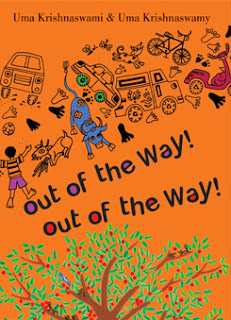Creativity Salon: An Interview With Uma Krishnaswami
Welcome to Bookjoy Creativity Salon, Uma! I so enjoyed the video on your site about your new book, Out of the Way! Out of the Way! Actually, I learned from each of the sections on your visually-appealing site
To begin, Uma, please tell us a bit about yourself.
I was a klutzy kid and I am now a klutzy adult. I love cats, and the colors purple and green. I like hiking, especially if rocks are involved. I knit when I revise, and I have graduated from scarves to socks. I am a very messy writer, and I throw away more words than I keep. Is that more than anyone might want to know?
1. You are from India and now live in New Mexico (though I didn’t know that until I spent time on your site). How has living in the United States affected your creative life and process?
I was born in India and live in the United States. This experience allows me to create a mental geography beyond one place. I’ve forged an identity that lets me cross national and cultural borders. It’s made me profoundly grateful for the many people on two continents who have supported and encouraged me to tell the stories that matter to me. I’ve seen the children’s and YA publishing industry in the US open its doors over the years to culturally grounded writing, so that I, a nobody in the writing universe, could dare to aspire to publication.
2. Your new book was previously published in India and has now been published by wonderful Groundwood Books, a press I admire. How has the publishing process been different?
The editorial process with Indian publisher Tulika Books was quite different from what I was used to. For one thing, even though I was corresponding with a single editor, I realized that all decisions were made in community, with many editorial meetings underlying each question raised. There was no one “editor” for my book—they all worked on everything. You’d think that might result in a hopeless muddle, but it was quite the reverse. Everything was deeply embedded in a vision for the work that went beyond individual opinions. The insights I gained from those exchanges led me away towards a stronger story with a longer reach.
3. In the video of Out of the Way! Out of the Way! You mention issues of plot and action. Do you see a move in U.S. children’s published away from “quiet books,” and a growing interest action, action, action?
Yes, especially in the realm of picture books. That saddens me. We live in such a frenetically paced world, that it seems all the more important for young children to learn the joys of stillness and quiet. But then I see books like Ashley Bryan’s glorious renderings of hymns, or Janet Wong’s Hide and Seek, and I think maybe there’s hope.
4. You also teach writing for children and young adults in Vermont College’s MFA program. Your web site section “Tips & Tools for Writers” has so much good advice. I particularly smiled at the last item, the witty note in which you reject an editor’s rejection letter. Is accepting rejection the most difficult challenge your students face?
In our business, oddly enough, lasting professional relationships, even deep friendships, can spring from criticism and rejection! But I think the most difficult challenge is to let go of one’s own words—to understand that the first words that come to mind may not last. They may reflect some mirage of the story that the author is still chasing. I tell my students to let go of the words, but not of the impulse that made the story bubble up in the first place.
5. What do you enjoy reading, Uma?
I often read three or four books simultaneously. In contemporary children’s and YA literature I like to read a sampling of books published outside the US as well, so I don’t get bogged down in a kind of “marketplace” mentality. I mix that up with books for grownups, to keep my mind flexible and open to options in my own writing. I’ve just finished Ursula Dubosarsky’s marvelous middle grade novel, The Golden Day, and am now reading The Art Forger by B.A. Shapiro and rereading Alain de Botton’s The Art of Travel.



Comments
Creativity Salon: An Interview With Uma Krishnaswami — No Comments
HTML tags allowed in your comment: <a href="" title=""> <abbr title=""> <acronym title=""> <b> <blockquote cite=""> <cite> <code> <del datetime=""> <em> <i> <q cite=""> <s> <strike> <strong>